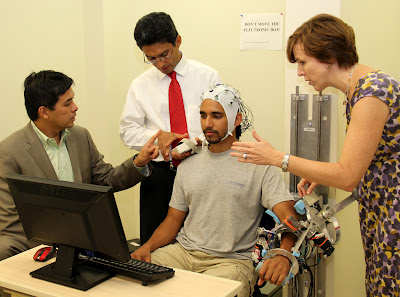

| Visitors Now: | |
| Total Visits: | |
| Total Stories: |

| Story Views | |
| Now: | |
| Last Hour: | |
| Last 24 Hours: | |
| Total: | |
Brain wave-reading robot exoskeleton might help stroke patients
From
A multidisciplinary team hopes to develop and validate a noninvasive brain-machine interface (BMI) to a robotic orthotic device that is expected to innovate upper-limb rehabilitation. The new neurotechnology will interpret brain waves that let a stroke patient willingly operate an exoskeleton that wraps around the arm from the fingertips to the elbow.
Rice is developing the exoskeleton and UH the electroencephalograph-based (EEG) neural interface. The combined device will be validated by UTHealth physicians at TIRR Memorial Hermann with as many as 40 volunteer patients in the final two years of the four-year R01 award, the oldest research grant offered by NIH. The grant, funded through the National Institute of Neurological Disorders and Stroke, is one of only a few projects selected by the NRI, a collaborative partnership by the NIH, National Science Foundation, NASA and the Department of Agriculture to encourage the development of the next generation of robots that will work closely with humans.
From left, Gerard Francisco, José Luis Contreras-Vidal and Marcia O’Malley work with a University of Houston (UH) graduate student testing MAHI-EXO II, a robotic rehabilitation device developed at Rice and being used at TIRR Memorial Hermann to help spinal-cord-injury patients recover. In a new project, a similar device will be matched with a noninvasive neural interface under development at UH to help rehabilitate stroke survivors. (Credit: Bruce French/TIRR Memorial Hermann)
See more and subscribe to NextBigFuture at 2012-09-05 09:01:04 Source: http://nextbigfuture.com/2012/09/brain-wave-reading-robot-exoskeleton.html
Source:



